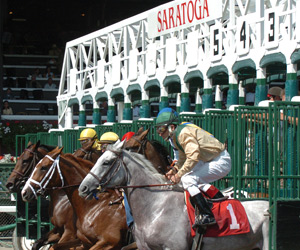 The image that I want to look at and discuss focuses on horses. For the majority of my life, I lived in Upstate NY near Saratoga. For those of you who don’t know, Saratoga is famous for its’ race track. This image centers around the relationship between horses and humans. As clearly shown in the picture, the jockey (human) is dependent on the horse. It is also widely believed and understood that there is a close knit relationship between horse and human. The assumptions regarding the relationship is that the human is primarily in control of the horse and will respond to the human’s commands. Along with that, the horse tends to “match” its’ jockey (similarly colored reigns) and both the human and horse are assigned a number. The image to me shows more of a competition between jockey to jockey and not a competition from horse to horse. I feel like there is more of a focus on the first jockey in the image than there is on the horse. The jockeys are the ones who seem focused on their goal with the tensed body language, whereas the horse seems more as if it is just there because it has to be based on its demeanor.
The image that I want to look at and discuss focuses on horses. For the majority of my life, I lived in Upstate NY near Saratoga. For those of you who don’t know, Saratoga is famous for its’ race track. This image centers around the relationship between horses and humans. As clearly shown in the picture, the jockey (human) is dependent on the horse. It is also widely believed and understood that there is a close knit relationship between horse and human. The assumptions regarding the relationship is that the human is primarily in control of the horse and will respond to the human’s commands. Along with that, the horse tends to “match” its’ jockey (similarly colored reigns) and both the human and horse are assigned a number. The image to me shows more of a competition between jockey to jockey and not a competition from horse to horse. I feel like there is more of a focus on the first jockey in the image than there is on the horse. The jockeys are the ones who seem focused on their goal with the tensed body language, whereas the horse seems more as if it is just there because it has to be based on its demeanor.
Before reading either Berger or Walker, I would not have really put in a lot of thought in regards to what this image represents to me. Especially since I grew up around this race track, it came off to me as incredibly normal and a part of daily life. I always automatically assumed that horses and their jockeys held some special bond and that they perceive each other as equals. However, after reading “Am I Blue?” by Walker, my perception changed. After reading Walker, I saw the horses in this image as being neglected. My perception changed from a passive view of the animal to an active one – and my active perception recognized that the horses are being treated solely as if they only possess instrumental value. Walker would disagree immensely with the entire concept of horse racing – as it does not take into account the horse’s needs and emotions. Along with that, Berger would also state that this is mistreating the animal. The horse in this image is not a horse – it is simply a number and a name used for entertainment and monetary purposes. With the entertainment culture surrounding this image, the horse loses all sense of individuality and “horseness” (Walker). The animal is entirely marginalized – no longer is a horse a horse, now it is a form of entertainment. The horse is nothing more to the general audience as a car would be in the Nascar world. The relationship between horse and jockey is also something that I may have overestimated in my mind, which I recognized after reading Walker. The jockey and the horse probably do share a relationship and a bond, but I still did not take into account that the jockey’s success and pride comes out of what the horse can give him; therefore the horse becomes an instrumental object in the jockey’s life. All in all, I realized that my perception shifted from a passive view to one that takes into account the intrinsic value of the horse, as well as recognizing how the horse is simply just an accessory to the human as shown in the image. After reading Berger and Walker, I now view horse racing as marginalizing the animal and shifting its’ value from intrinsic to instrumental.
Do you think your upbringing around horses and animals has made you more sympathetic or more understanding of our relationship with animals, specially ones that tend to have a large amount of human interaction. You might see your childhood allowing you to appreciate animals more, or you could use it at justification for concepts such as dualism and applying instrumental or intrinsic value to them, great post!
That’s a great question, Nick. Thanks for raising it.